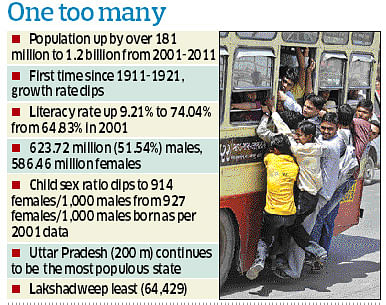We are still booming, but at a slower rate
This is the first time there has been an appreciable decline in the decadal growth rate since independence. “The percentage decadal growth during 2001-2011 has registered the sharpest decline since independence, a decrease of 3.90 percentage points,” the provisional report noted.
The 2001-2011 period is the first decade, with the exception of 1911-1921, which added less population compared to the previous decades, Registrar General of India and Census Commissioner of India C Chandramauli said here in the presence of Home Secretary G K Pillai while releasing the data.
The decadal exercise — the 15th headcount of India's population since 1872 — is undertaken to create a database on demography, economic activity, literacy and education, housing and household amenities, urbanisation, fertility and mortality, social structure, language, religion and migration.
According to the data, the literacy rate has gone up from 64.83 per cent in 2001 to 74.04 per cent in 2011, showing an increase of 9.21 per cent. Literates constitute 74 per cent of the total population aged seven and above and illiterates form 26 per cent.
The country’s population, which accounts for 17.5 per cent of the world’s population, comprises 623.7 million males and 586.5 million females, the provisional results show. China is the most populous nation acounting for 19.4 per cent of the global population.
The country’s headcount is almost equal to the combined population of the United States, Indonesia, Brazil, Pakistan, Bangladesh and Japan put together, the report said. Delhi's population soared to 1.67 crore over the last 10 years — an increase of 29 lakh — while the sex ratio has gone up to 866 per 1,000 males from 821 in 2001. The total population of the national capital, which accounts for 1.38 per cent of the country’s total population, comprises 89.89.76 lakh males and 77.76 lakh females.
The report noted that the male population in the country rose by 17.19 percent to reach 62 crore while the female population soared by 18.12 percent to reach 58 crore.
While the data indicates a rise of 17.64 per cent in the country’s population in the decade, the overall sex ratio at the national level was recorded to have gone up by seven points since the Census 2001 to reach 940 at Census 2011, the highest sex ratio recorded since 1971 and a shade lower than 1961.
The headcount exercise found that Uttar Pradesh continues to be the most populous state with over 19.95 crore people and Lakshadweep the least populated at 64,429, while the combined population of UP and Maharashtra is bigger than that of the United States. The other most populous states are Maharashtra (11.23 crore), Bihar (10.38 crore), West Bengal (9.13 crore) and Andhra Pradesh (8.46 crore).
The population density of the country was found to have gone up to 382 persons per square kilometer. Among the states, Bihar was found to be the most densely populated with 102 persons per square kilometre and Arunachal Pradesh the least densely populated state with 17 persons per square kilometre. The Census indicated a continuing preference for male children over female children. The latest child sex ratio in is 914 female against 1,000 male—the lowest since Independence. “This is a matter of grave concern,” Chandramauli said.

Deccan Herald is on WhatsApp Channels| Join now for Breaking News & Editor's Picks